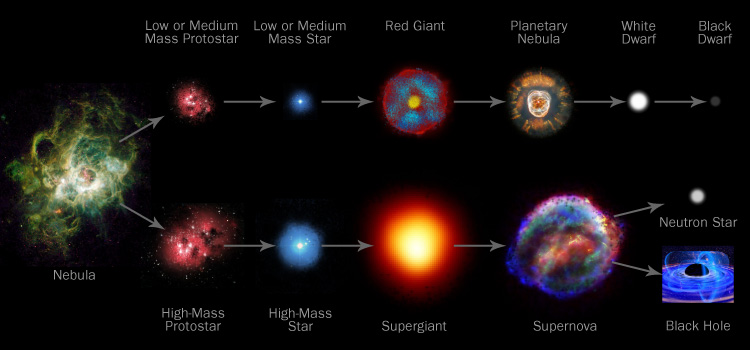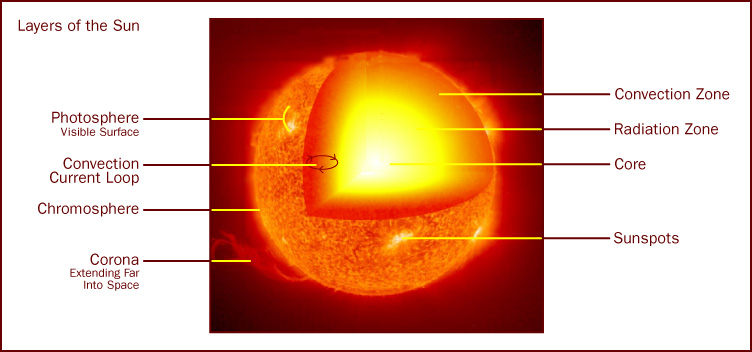 username@email.com
username@email.com
Stars do not last forever; they are born, have a (relative to humans) long life, and usually fade out or transform into another kind of object. All stars and galaxies initially form from a nebula, a large volume of gas and dust. When enough gas and dust contract from gravity, a star can begin to form. At this early stage of development, when the contracting clouds of dust and gas contain enough mass to eventually form a star, the fledgling star is known as a protostar.
A star is “born” when the density of the contracting gas and dust causes intense heat and pressure, enough to start a nuclear fusion reaction. Recall that nuclear fusion occurs when individual atoms combine to form heavier atoms and in the process, release tremendous amounts of energy. In most stars, hydrogen atoms combine with other hydrogen atoms to become helium atoms.
The composition of most stars is about 73% hydrogen, 25% helium, and 2% of other elements with atomic numbers up to, but not exceeding, that of iron.
The lifetime of a star depends on its mass. Although you would assume that a star with a large mass would have a longer lifetime than a star with a smaller mass, the opposite is true. Stars with smaller masses have longer lifetimes than more massive stars. You know intuitively that a small car can drive farther (run longer) than a large car on a single tank of gas. If smaller cars have smaller gas tanks how can they drive longer on a tank of gas? Simple; small cars also have smaller, much more fuel-efficient engines, and smaller cars weigh less than larger cars. On the other hand, a large car with a larger gas tank requires a bigger, engine which will burn gas faster. Using the same analogy for stars, even though small stars have less mass (fuel) to use, they use it more slowly than larger stars and have much longer life spans.
Stars go through a life cycle, eventually dissolving or transforming into another type of celestial body. When a star approaches the consumption of all its fuel, its outer gases expand as the central core shrinks. At the time of death (when a star runs out of fuel to burn), the original mass of the star will determine if it becomes a red giant or a supergiant. Both of these transformed stars can evolve in different ways and become black holes, neutron stars, or black dwarves.
Stars of low to medium mass, such as our sun, require billions of years to consume all their fuel. As they start to use up all the fuel, their outer layers expand and they become red giants. Eventually, as their outer regions grow larger and drift further out into space, forming a glowing cloud of gas called a planetary nebula. The core of the star that is left behind has a bluish-white color and cools to become a white dwarf.
White dwarfs are relatively small (about the size of the Earth) but they are very dense, having similar mass as our sun, but with a small volume. This gives white dwarfs a density about one million times the density of the sun. A tablesppon full of this material would have as much mass as a 20-story building on Earth. Having no fuel, white dwarfs glow faintly from leftover energy, and after billions of years, eventually stop glowing and become black dwarfs.

Life history of stars and other celestial bodies depends on their original mass.
Unlike the life cycle of a low- to medium-sized star, the life of a more massive star ends quickly in a brilliant catastrophic explosion. When a supergiant consume all its fuel, it collapses into its core, creating a tremendous increase in heat and pressure within the core. The immense heat cannot easily radiate away causing the start to suddenly explode, becoming much larger and millions of times brighter. This can happen in a matter of a few hours and the explosion is called a supernova. After the supernova phase, much of the star’s original material expands into space, probably to become part of another nebula or protostar.
Some of the material from a star is left behind when a supergiant explodes and may form a neutron star. A neutron star is the remains of a star that once was very massive. They are even smaller and denser than white dwarfs, and while they can contain up to three times the mass of our sun, they can have a diameter as small as 24 km – the size of a typical city. These are truly massive and dense objects.
Stars with a relatively small mass have what type of lifespan compared to more massive stars?
The correct answer is D. Small stars have long life spans. Larger stars live shorter and more intense lives, comparatively.
The sun, like all stars, does not have a solid surface. It is a big ball of gas atoms in what is called the plasma state of matter; they are atoms that have their electrons stripped away. Similar to Earth, however, it does have an interior and an atmosphere. The sun’s interior consists of the core, the radiation zone, and the convection zone.
The sun’s core is where all the energy is produced. This energy is not generated by burning fuel but rather by the process of nuclear fusion, where hydrogen atoms combine to form heavier elements (usually helium) along with a tremendous release of energy. The mass of the helium produced is less than the mass of the hydrogen atoms consumed, and the difference in mass is transformed into energy.
The energy produced in the core migrates to the next layer of the sun, the radiation zone, which is the middle layer of the sun’s interior and the region of dense gas where energy is transferred into electromagnetic radiation. The radiation zone is extremely dense and it can take more than 100,000 years for energy to move through it.
The convection zone is the outer layer of the sun’s interior where hot gases rise from the bottom of the convection zone. These hot gases gradually cool as they reach the top of the convection zone, only to sink again, heat up again, and form loops of gas that are transported toward the sun’s surface.
The sun’s atmosphere consists of three layers: the photosphere, the chromosphere, and the corona. The photosphere is the innermost layer of the sun’s atmosphere and is considered to be the visible surface of the sun. It is made up of gases because the sun does not have a solid surface. The chromosphere is the thin middle layer of the sun’s atmosphere that is usually not visible because of the bright glare from the photosphere. The chromosphere can only be seen during a total solar eclipse when the moon blocks the light from the photosphere. Then, the reddish glow of the chromosphere just above the photosphere can be seen. The corona is the outermost layer of the sun’s atmosphere, which extends about one- and-a-half million km into space from the sun’s surface.

What is the sun’s photosphere?
The correct answer is A. The other answers are defining other parts of the Sun.